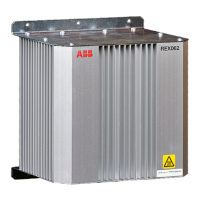7.3.2 Application
Short circuit between the phases of the stator windings causes normally very large
fault currents. The short circuit generates risk of damages on insulation, windings and
stator core. The large short circuit currents cause large current forces, which can
damage other components in the power plant, such as turbine and generator-turbine
shaft. The short circuit can also initiate explosion and fire. When a short circuit occurs
in a generator there is a damage that has to be repaired. The severity and thus the repair
time are dependent on the degree of damage, which is highly dependent on the fault
time. Fast fault clearance of this fault type is therefore of greatest importance to limit
the damages and thus the economic loss.
To limit the damages in connection to stator winding short circuits, the fault clearance
time must be as fast as possible (instantaneous). Both the fault current contributions
from the external power system (via the generator and/or the block circuit breaker) and
from the generator itself must be disconnected as fast as possible. A fast reduction of
the mechanical power from the turbine is of great importance. If the generator is
connected to the power system close to other generators, the fast fault clearance is
essential to maintain the transient stability of the non-faulted generators.
Normally, the short circuit fault current is very large, that is, significantly larger than
the generator rated current. There is a risk that a short circuit can occur between phases
close to the neutral point of the generator, thus causing a relatively small fault current.
The fault current fed from the generator itself can also be limited due to low excitation
of the generator. This is normally the case at running up of the generator, before
synchronization to the network. Therefore, it is desired that the detection of generator
phase-to-phase short circuits shall be relatively sensitive, thus detecting small fault
currents.
It is also of great importance that the generator short circuit protection does not trip for
external faults, when large fault current is fed from the generator. In order to combine
fast fault clearance, sensitivity and selectivity the Generator current differential
protection GENPDIF is normally the best choice for phase-to-phase generator short
circuits.
The risk of unwanted operation of the differential protection, caused by current
transformer saturation, is a universal differential protection problem. If the generator
is tripped in connection to an external short circuit, this can first give an increased risk
of power system collapse. Besides that, there can be a production loss for every
unwanted trip of the generator. Hence, there is a great economic value to prevent
unwanted disconnection of power generation.
The generator application allows a special situation, where the short circuit fault
current with a large DC component, can have the first zero crossing of the current,
after several periods. This is due to the long DC time constant of the generator (up to
1000 ms), see figure
67.
GENPDIF is also well suited to give fast, sensitive and selective fault clearance, if
used for protection of shunt reactors and small busbars.
Section 7 1MRK 502 071-UEN -
Differential protection
168 Generator protection REG670 2.2 IEC and Injection equipment REX060, REX061, REX062
Application manual

